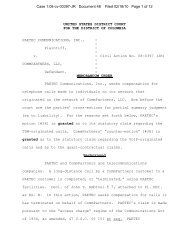QUANTA SERVICES INC, QUANTA SERVICES MANAGEMENT ...
QUANTA SERVICES INC, QUANTA SERVICES MANAGEMENT ...
QUANTA SERVICES INC, QUANTA SERVICES MANAGEMENT ...
Create successful ePaper yourself
Turn your PDF publications into a flip-book with our unique Google optimized e-Paper software.
WiMAX backhaul communications will cause the cell relays associated with that segment to fail over to the secondary path, a public cellular carrier (AT&T)<br />
network.<br />
The smart grid communications model was developed as an end-to-end design with dual communications paths to provide redundancy. By implementing a<br />
private wireless infrastructure as a primary communications path and using a public cellular carrier as the secondary path, CenterPoint was able to use the<br />
full strengths of both types of networks to create a reliable solution. This redundancy and resiliency enables CenterPoint to live up to its brand promise:<br />
"Always there."<br />
Communications Network Build<br />
Smart meters transmit electric usage data wirelessly to cell relays installed on electric distribution poles connected to both the WiMAX and cellular networks.<br />
More than 5,200 cell relay sites have been built across Houston to communicate with the more than 2 million meters installed across CenterPoint's electric<br />
distribution territory.<br />
The cell relay location consists of a cell relay, a wireless WiMAX remote radio and an antenna - all of which are powered by electricity from the power line<br />
with battery back-up. For approximately every 75 cell relay locations, there is a WiMAX radio tower site that functions as a take-out point (TOP) to collect<br />
the data.<br />
At the cell relay sites, communications crews program the WiMAX radio and then align the antenna to ensure the radio is communicating with the TOP. TOPs,<br />
which are built mainly at CenterPoint substations, collect data from cell relays within a several-mile radius and deliver the data, through the microwave and<br />
fiber backhaul network, to the data center.<br />
The TOP consists of a 150-ft (46-m) steel lattice tower or pole. On the structure, crews installed three WiMAX antennas, spaced 120 degrees apart, to<br />
receive signals from surrounding cell relays. In addition, crews installed and aligned the microwave dish to connect with the core network through an<br />
adjacent microwave location. The telecommunications equipment for the TOP is sheltered inside a concrete building at the base of the tower or pole. Cell<br />
relay data collected through one of three master radios - one for each antenna - is routed over the microwave network by fiber-optic cable to the data<br />
center.<br />
A data collection engine passes information collected from the cell relays to the meter data management system, which processes and stores meter data and<br />
also executes service orders. CenterPoint sends meter data to the Smart Meter Texas web portal, where consumers may securely view their historical 15minute<br />
usage data in 24-hour, 30-day and 13-month snapshots.<br />
The Network Takes Shape<br />
More than 2.2 million smart meters have been deployed, along with 5,220 cell relays and 140 TOPs. With these in place, more than 2 billion intervals of<br />
usage data are being recorded and made available to consumers on the Internet each week.<br />
In 2012, CenterPoint has obtained 15-minute interval data at a rate of 99.3%, along with 99.8% of monthly register reads used for billing. More than 97%<br />
of service orders have been completed electronically, typically within 30 minutes, saving nearly 3 million truck rolls, with concomitant savings in fuel and<br />
reduction of carbon emissions.<br />
Considerations and Lessons Learned<br />
The real test of a communications network is how it functions in practice. The deployment process posed its own challenges and taught some significant<br />
lessons:<br />
Communications network development must be closely coordinated with the meter deployment. CenterPoint's meters were deployed by route, and the<br />
network communications infrastructure was in place and stable three months ahead of the meter deployment. This approach allowed meters to begin<br />
communicating with the system immediately.<br />
Be prepared to use creative design and installation solutions to meet aggressive time lines. For example, one of the tests performed at potential cell relay<br />
sites was to determine WiMAX signal strength to the WiMAX take-out site. When signal testing to a cell relay site was needed before the take-out site towers<br />
were built, large cranes were used to position the antennas at the appropriate height.<br />
Complete the design of the overall communications system up front. Integrate all communications components into an overall architecture, test and analyze<br />
all equipment, complete construction standards, identify all construction materials and validate installation procedures through testing and training.<br />
Manage materials and multiple service suppliers closely and establish strong field coordination along with detailed construction and performance acceptance<br />
and testing processes. Major equipment and long-lead items such as cell relays, radios, network electronics, towers and buildings need to be specified, bid<br />
on and ordered well in advance, and inventory levels maintained in a warehouse system and tracked. Given the fast pace of deployment, inadequate<br />
inventory can cause significant schedule disruptions.<br />
Be prepared to support the infrastructure operationally when the first device goes into production. Identify staffing requirements and analyze, select and<br />
implement network management tools as they are used both for construction and for connectivity testing and operations.<br />
Leverage a common communications infrastructure. The intelligent grid network is built to leverage the advanced metering system communications<br />
infrastructure so remote or automated switching commands are executed over the same network from which electric usage data is communicated.<br />
Keys to Deployment Success<br />
Page 21 of 26<br />
An effective communications network has CenterPoint positioned for the future. The smart grid is not only the future for CenterPoint, it is the future of the<br />
utility industry. With this in mind, the following approaches may be considered when planning any smart grid communications system:<br />
Establish a strong governance process. A strong project management office, using a proven governance methodology, is essential to the overall success.<br />
With the deployment of any integrated system, especially one as complex as an advanced meter system, the application of consistent scheduling, financial,<br />
scope, change and reporting processes is imperative.<br />
http://search.proquest.com.ezproxy.spl.org:2048/printviewfile?accountid=1135<br />
12/6/2012

















